How to remove watermarks and water stains from wood furniture
You told them to use a coaster and they didn't listen! But don't worry – your coffee table can be saved...

So someone put their cup down on your favourite coffee table without using a coaster. But before you write them out of your life forever, try this simple repair. It should help return any wooden surface to its former glory, and keep friendships intact!
Another weekend project: New Ikea hack to give drawers a sophisticated makeover
It comes to us from the fabulously talented Alex Webster, a star of new series Salvage Hunters: The Restorers. Alex is an expert antiques restorer, French polisher and furniture maker, so he knows what he's talking about!
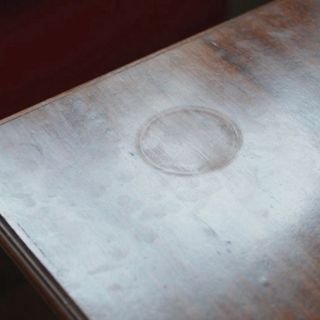
What you will need
- Extra fine 0000 grade wire wool
- Soft cloth
- Cotton wool
- French polish
- Methylated spirits
How to remove water stains from wood furniture
1. Sand down the stain
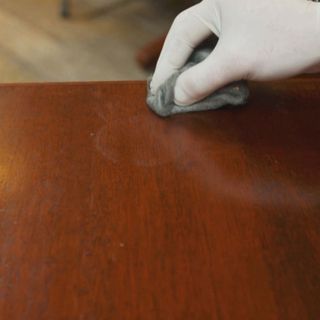
Start rubbing gently with the grain of the wood and then increase the pressure until it starts to disappear. You’ll now have a matt patch where the stain was.
2. Prepare the French polish mix
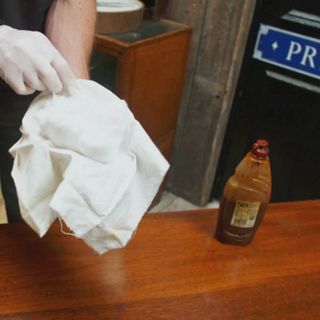
Combine a mixture of half French polish with half methylated spirits in a squeezy bottle. French polish on its own is a little too thick to apply, so this technique thins down the mixture.
Get it done: How to fix squeaky floorboards, block draughts and repair broken boards
3. Prepare the cloth
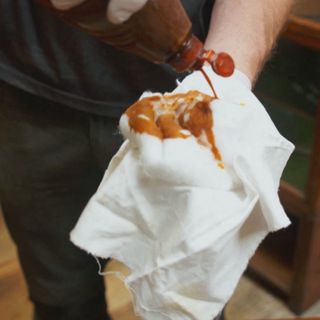
Tear off a ball of the cotton wool and fold it over into the size of a small apple. Place the cotton wool ball into the middle of the cloth, and pour a little of the mixture on top. Fill the cloth with the cotton wool ball, scrunch it together and give it a twist.
Get the Ideal Home Newsletter
Sign up to our newsletter for style and decor inspiration, house makeovers, project advice and more.
4. Apply the polish
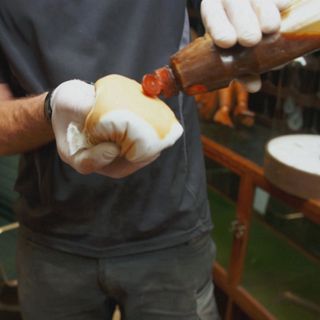
Give the ball a little pat on the back of your hand to get a flat surface and twist again until it starts to soak through the cloth. Then apply a little more to the face of the cloth and start with very slow, straight and gentle strokes across the surface. Make sure not to overlap too soon, it must dry before you do another stroke across the same spot.
5. Nail the technique
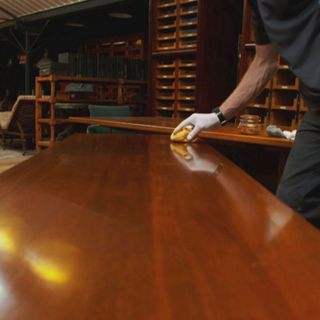
'The important thing with French polishing is to be patient and use long, steady strokes,' says Alex. 'Drop off the end of the furniture and then hit it moving again.' Also, be sure not to let it get too dry – if it gets too dry you’ll feel it dragging and it’ll take the existing French polish off. Equally, if you let it get too wet, it’ll get really sticky and you’ll get a poor-quality finish.
Salvage Hunters: The Restorers premieres exclusively in the UK on Quest, 9pm, Wednesday 4th April 2018 (Freeview 37, Freesat 167)

Amy Cutmore is an experienced interiors editor and writer, who has worked on titles including Ideal Home, Homes & Gardens, LivingEtc, Real Homes, GardeningEtc, Top Ten Reviews and Country Life. And she's a winner of the PPA's Digital Content Leader of the Year. A homes journalist for two decades, she has a strong background in technology and appliances, and has a small portfolio of rental properties, so can offer advice to renters and rentees, alike.
-
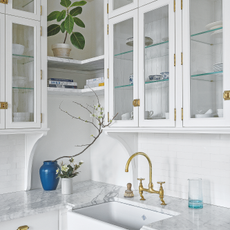 Professional organiser reveals the room in your house you should always declutter first for a successful clear-out
Professional organiser reveals the room in your house you should always declutter first for a successful clear-outIt turns out your kitchen is the best place to start when tackling a big declutter
By Kezia Reynolds
-
 6 tricks I use to display pans in a kitchen as an interior stylist that are both practical and pretty
6 tricks I use to display pans in a kitchen as an interior stylist that are both practical and prettyShow off pots and pans in style with these smart ideas
By Laurie Davidson
-
 I used to spend a fortune on fresh basil - but this £99 device has turned my kitchen worktop into an indoor herb garden
I used to spend a fortune on fresh basil - but this £99 device has turned my kitchen worktop into an indoor herb gardenHow does this tiny indoor garden work?
By Molly Cleary